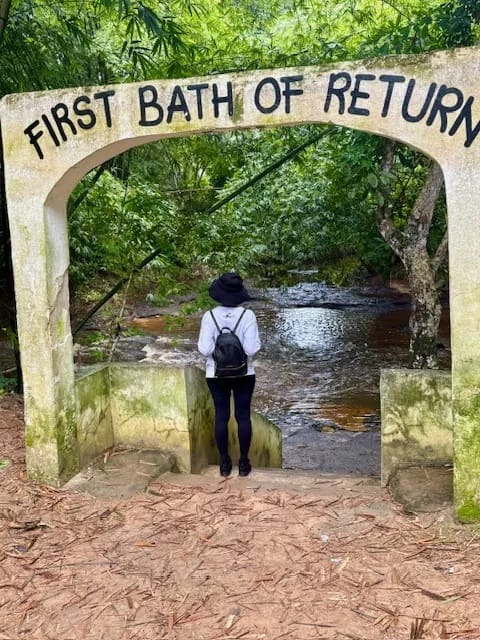As I walked barefoot along the same dirt path that once led kidnapped Africans to the Assin Manso River in Ghana, I felt the weight of history in every step.
When I finally placed my feet in the cool, flowing water — where European traders forced enslaved Africans to bathe before sale — I began to understand something that had long hovered just outside my comprehension.
The world’s fear of Black people isn’t just about skin color. It’s about strength. It’s about resilience.
That fear goes back centuries.
After enduring long, punishing treks — sometimes as far as 1,000 miles from inland villages across West Africa — captives were brought to this river. Shackled and exhausted, they were made to wash in the Assin Manso. Not out of care or dignity. But because slave traders didn’t want them to appear as “damaged goods.” They were prepared for market.
Once cleansed, their skin was rubbed with shea butter to shine — literally — to look appealing to buyers. Then, they were forced to march another 20 to 40 miles to slave castles along the coast. Places like Elmina and Cape Coast, where they were held in dark, airless dungeons for weeks or months until European ships arrived to carry them across the Atlantic.
I stood in these musty dungeons on the same floors where Africans were forced to sleep on top of each other in their own feces and blood. Most people wouldn’t last a day.

We often date the beginning of Black enslavement in America to 1619, when 20 enslaved Africans were brought to Jamestown. But in truth, the transatlantic slave trade had already been thriving for over a century by then. Portugal and Spain had been trafficking Africans since the 1440s.
Over the next 400 years, millions were taken from the continent.

Slavery in the United States wasn’t just about labor. It was about the complete dehumanization of a people — systematic violence, forced illiteracy, broken families, and stolen futures. And even when the Civil War ended slavery in 1865, freedom didn’t follow.
Instead, it gave way to nearly a century of Black Codes and Jim Crow laws. These were not simply “segregation” laws. They were legal frameworks built to criminalize Black existence, to re-enslave Black people through prison labor, and to suppress every attempt at political or economic empowerment.
There was also the era of racial terror — lynchings, white supremacist massacres like Tulsa (1921), Rosewood (1923), and Wilmington (1898) — when Black communities that dared to thrive were burned to the ground.
Then came redlining, school segregation, voter suppression, mass incarceration, and police brutality dressed up as law and order.
I was in 6th grade in 1980 when my city of Columbus, Ohio finally integrated most of the public schools that still were segregated.
And yet — in spite of all this — Black people rose.
Black people built businesses. Composed symphonies. Wrote novels. Led freedom marches. Won Nobel Prizes. Became mayors, governors, senators, and yes — a President.
We are told, again and again, that Black people are less than. That centuries of systemic violence should have broken them beyond repair. And yet here they are, not just surviving but shining — like the shea-buttered skin of their ancestors.
And that’s what they fear most.
They fear the strength it takes to endure 500 years of trauma and still rise with dignity.
They fear the brilliance that emerges when a people are forced to forge genius out of struggle.
They fear the unity that blooms when oppression fails to crush a soul.
They fear that if the playing field is ever leveled, Black people might not just catch up — they might lead.
Today, racial disparities in the persist in nearly every area of American society:
- Black families hold one-tenth the wealth of white families.
- Black mothers die at three times the rate of white mothers during childbirth.
- Black students are suspended more often and given fewer resources.
- Black drivers are stopped and searched more frequently by police.
- Black workers are paid less for the same work, denied promotions, and often overlooked.
- Black communities lack access to clean water at far greater rates than similarly positioned white communities.
This is no accident. It’s the legacy of a system built on the assumption that Black people should never be equal.
And yet, still, Black people persevere.
They’ve built culture, shaped global music, led moral revolutions, and turned pain into poetry.
They’ve transformed every field they’ve been allowed into.
They’ve survived the river, the auction block, the plantation, the chain gang, the ghetto, and the prison.
They are still here. And they are not broken.
That’s what people are scared of.
This post originally appeared on Medium and is edited and republished with author's permission. Read more of Jeffrey Kass' work on Medium.
